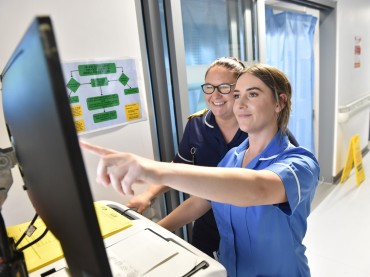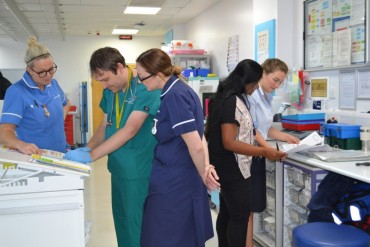What is intravenous sedation?
The child in your care may require intravenous sedation for dental treatment. The use of a sedative drug (medicine) makes the child drowsy and relaxed and less aware of the treatment. The patient will often have few memories of what has happened during the treatment.
Intravenous sedation does not make your child unconscious. Intravenous sedation is usually given by using a single drug called midazolam. A dose, determined for your child individually, will be given into a vein in the back of the hand or arm using a cannula (a thin flexible tube). A needle is used to put the cannula into the vein and the needle is then removed straight away. Once the cannula is in the vein, the sedation drug can be given without using any more needles. The cannula remains in until the dentist has checked that you child has recovered but it will be removed before going home.
A cream containing local anaesthetic may be used to make the injection site numb before the cannula is inserted.
You may be asked to put this cream on the child’s hand or arm before you leave home. This allows enough time for it to work properly before having the sedation medicine.
Intravenous sedation is used to reduce anxiety and fear of dental treatment. This makes children more co-operative when having dental treatment. It is particularly helpful if children are having a long, uncomfortable or more complicated procedure. The dentist and members of the dental team are trained to give sedation. They watch the child closely and treat any problems that may develop.
They are required to use appropriate monitoring equipment during sedation. The child will go to a recovery area after the treatment where he or she will be observed until having made a full recovery from the sedation.
It is a widely used technique but, as with the administration of any medicines, there are risks associated with intravenous sedation. Risks include:
• A reduction of oxygen in the blood stream due to poor breathing during sedation. The child may be asked by the dentist/ sedationist to take deep breaths to correct this The dentist/ sedationist will continually monitor the child’s breathing and oxygen levels throughout the procedure.
• Bruising at the site of the cannula. This may take several days to fade completely.
Very rare risks are allergic reactions to the sedative drugs your child has been given or vomiting during the procedure. The dentist/ sedationist will discuss any concerns that you may have about the child prior to the procedure taking place.
The various methods of dental treatment planned for the child will be discussed with you at an assessment appointment following a full dental examination.
The dental treatment planned will then take place at a second or subsequent appointment. In an emergency, the treatment may be carried out on the same day as assessment.
If it is agreed that intravenous sedation is the best way to treat the child, then the dentist will confirm:
• The child’s height and weight
• The child’s blood pressure – taken with a cuff on the child’s arm. This may not happen for young children.
• The level of oxygen in the blood – taken with a simple clip on the child’s finger
• The child’s medical history. If further information is required at this stage, the child’s general medical practitioner or specialist will be contacted.
If you have any questions or are unsure about the sedation planned for the child, do not hesitate to ask the dentist.
The dentist will discuss with you and explain what the child is able to eat and drink prior to the appointment. You will also be given this information in writing. It is important that these instructions are followed carefully.
Written consent will be required from the parent/carer before any treatment can be given to the child. If you have agreed and signed the consent form at the assessment appointment and you are then unable to attend with the child on the day of treatment, the child must be accompanied by a responsible adult (over 18 years of age). Please give any routine medicines as normal.
Any medicines or inhalers that the child may need should be brought with you to the appointment. Dress your child in loose, comfortable clothing. No valuables should be brought to the appointment. If the child is unwell on the day of treatment with cold/flu symptoms or any contagious illness, please contact the dentist for advice.
The appointment may need to be rearranged. Please avoid bringing other children with you on the day of treatment.
The child will be monitored during the procedure. This will include measurements of blood pressure, heart rate and oxygen levels at regular intervals. Once the child is sedated, and feels drowsy and relaxed, the dentist can use local analgesia (pain relief that numbs the site of the dental treatment). Local anaesthetic as a paste is sometimes used to numb the site of the treatment.
Any injections that the child may need can then be given through this numbed area to reduce the chance of any discomfort.
After the treatment has finished, the child will spend some time in the recovery area and will not be allowed to go home until alert and responsive. The dentist will check the patient before he or she is allowed to go home. The child may not return to school and should not participate in active sports for the rest of the day. You may wish to make plans about how best to travel home with the child following the treatment. The child must be supervised by a responsible adult for the rest of the day.
Arrangements may need to be made for the care of other children or elderly dependent relatives during this time. Children can be sleepy, upset or agitated for up to 3 hours after the treatment. They will, however, have little memory of the procedure.
Occasionally, children feel a bit sick or may get hiccups. There may be some bruising on the hand or arm where the sedative medicine was given. You will be given information relating to any local analgesia and the treatment the child has received.
The dental team will advise you about any medicines the child may need while recovering from the treatment. You will be given a telephone number of who to contact in case of any concerns.
Information from Standards for Conscious Sedation in the Provision of Dental Care (V1.1). 2020. The dental faculties of the Royal Colleges of Surgeons and the Royal College of Anaesthetists.



